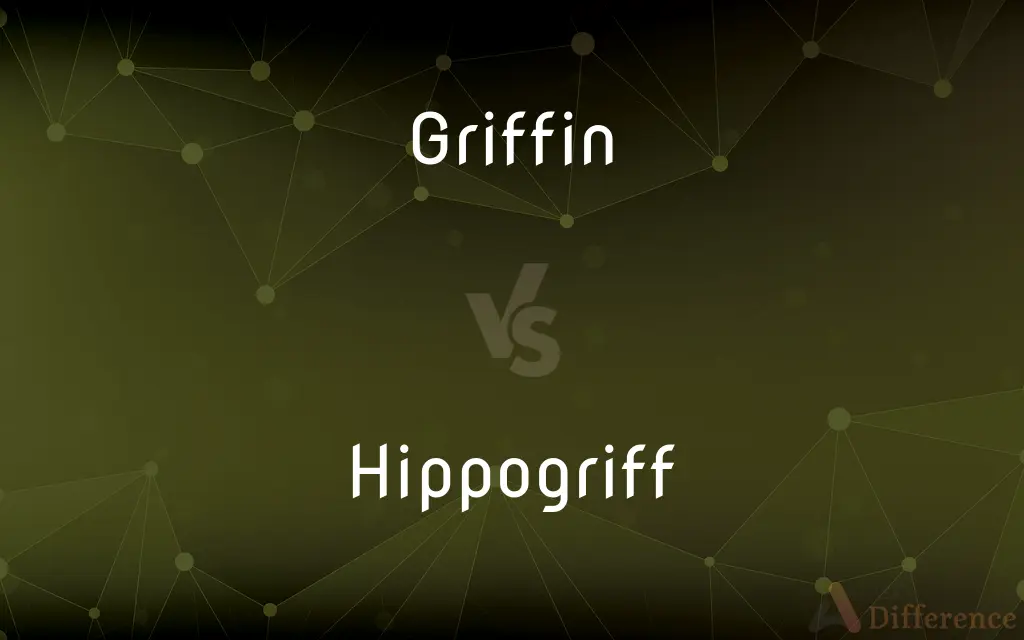Griffin vs. Hippogriff — What's the Difference?
By Tayyaba Rehman — Updated on September 7, 2023
A Griffin is a mythical creature with the body of a lion and the head of an eagle. A Hippogriff is a fictional beast, part griffin and part horse, with the body of a horse and the wings and head of an eagle.

Difference Between Griffin and Hippogriff
Table of Contents
ADVERTISEMENT
Key Differences
A Griffin is a creature rooted in ancient mythology, commonly depicted as having the body of a lion and the head and wings of an eagle. A Hippogriff, by contrast, is a creature of more recent lore, blending the features of a Griffin and a horse to create a creature with the body of a horse and the wings and head of an eagle. While Griffins are often symbolic of majesty and strength, drawing from both the king of beasts and the king of birds, Hippogriffs symbolize the fantastic or the impossible, often used to denote something that is exceptionally rare or unattainable.
Griffins are widely recognized and respected within various cultures and their symbolism is rich, often representing protection, courage, and strength. Hippogriffs, however, are mostly known from specific literary works like those of Ludovico Ariosto and J.K. Rowling, and they do not possess the same depth of cultural symbolism. Unlike Griffins, Hippogriffs are less commonly featured in historical tales and mythologies.
In terms of physical attributes, Griffins typically have the body of a lion, a symbol of strength and bravery, and the head and wings of an eagle, signifying vision and freedom. Hippogriffs, on the other hand, combine these eagle features with the body of a horse, symbolizing speed and agility. While Griffins are often seen as guardians or protectors, Hippogriffs are often portrayed as noble steeds, capable of tremendous feats of flight and speed.
Interestingly, Griffins are often depicted as singular, majestic creatures that are both feared and respected. Hippogriffs are more commonly viewed as creatures of fantasy literature and are not as deeply rooted in ancient folklore as Griffins. While the Griffin is often associated with divine protection and spirituality, the Hippogriff is more commonly aligned with the realms of pure fantasy and imagination.
Comparison Chart
Composition
Lion body, eagle head
Horse body, eagle head
ADVERTISEMENT
Symbolism
Strength, courage
Fantasy, impossibility
Origin
Ancient mythology
Literary works
Physical Traits
Lion body, eagle head/wings
Horse body, eagle head/wings
Cultural Depth
Rich cultural history
Limited to specific literature
Compare with Definitions
Griffin
A mythical creature with the body of a lion and the head of an eagle.
The ancient temple was guarded by statues of Griffins.
Hippogriff
A mythical beast that is part Griffin and part horse.
He rode a Hippogriff in the fantasy novel.
Griffin
Often represents protection and majesty.
The Griffin in the painting was seen as a divine guardian.
Hippogriff
Known for its speed and agility.
The Hippogriff soared through the sky at incredible speeds.
Griffin
A symbol of strength and courage in various cultures.
Griffins were often emblazoned on medieval coats of arms.
Hippogriff
Commonly portrayed as noble steeds in fantasy literature.
The hero mounted the Hippogriff and flew off to his next adventure.
Griffin
Featured in both Eastern and Western mythologies.
Griffins are as popular in Persian lore as they are in Greek mythology.
Hippogriff
Originates from literary works rather than ancient mythology.
Hippogriffs gained fame through Ariosto's Orlando Furioso.
Griffin
Frequently depicted as a guardian or protector.
The Griffin is a common motif in ancient architecture for protective purposes.
Hippogriff
Symbolizes the fantastic or the impossible.
Hippogriffs are often used to denote something extraordinarily rare.
Griffin
The griffin, griffon, or gryphon (Ancient Greek: γρύψ, grū́ps; Classical Latin: grȳps or grȳpus; Late and Medieval Latin: gryphes, grypho etc.; Old French: griffon) is a legendary creature with the body, tail, and back legs of a lion; the head and wings of an eagle; and sometimes an eagle's talons as its front feet. Because the lion was traditionally considered the king of the beasts, and the eagle the king of the birds, by the Middle Ages, the griffin was thought to be an especially powerful and majestic creature.
Hippogriff
The hippogriff, or sometimes spelled hippogryph (Greek: Ἱππόγρυπας), is a legendary creature with the front half of an eagle and the hind half of a horse. It was invented by Ludovico Ariosto in his Orlando Furioso, at the beginning of the 16th century.
Griffin
A fabulous beast with the head and wings of an eagle and the body of a lion.
Hippogriff
A monster having the wings, claws, and head of a griffin and the body and hindquarters of a horse.
Griffin
A mythical beast having the body of a lion and the wings and head of an eagle.
Hippogriff
A mythical beast, half griffin and half horse, supposedly the offspring of a griffin and a filly.
Griffin
A large vulture (Gyps fulvus) found in the mountainous parts of Southern Europe, North Africa, and Asia Minor, supposed to be the "eagle" of the Bible.
Hippogriff
A fabulous winged animal, half horse and half griffin.
Griffin
An English variety of apple.
Griffin
A person who has just arrived from Europe.
Griffin
A cadet newly arrived in British India: half English, half Indian.
Griffin
A watchful guardian, especially a duenna in charge of a young woman.
Griffin
An Anglo-Indian name for a person just arrived from Europe.
Griffin
A fabulous monster, half lion and half eagle. It is often represented in Grecian and Roman works of art.
Griffin
A representation of this creature as an heraldic charge.
Griffin
A species of large vulture (Gyps fulvus) found in the mountainous parts of Southern Europe, North Africa, and Asia Minor; - called also gripe, and grype. It is supposed to be the "eagle" of the Bible. The bearded griffin is the lammergeir.
Griffin
An English early apple.
Griffin
Winged monster with an eagle-like head and body of a lion
Common Curiosities
What do Hippogriffs symbolize?
They symbolize the fantastic or the impossible.
What is a Griffin?
A mythical creature with the body of a lion and the head of an eagle.
What is a Hippogriff?
A fictional creature that is part Griffin and part horse.
What do Griffins symbolize?
They often symbolize strength, courage, and protection.
Where did Griffins originate from?
They have origins in ancient Eastern and Western mythologies.
Where did Hippogriffs originate from?
They are primarily a creation of literary works.
What are the physical traits of a Hippogriff?
They have the body of a horse and the head and wings of an eagle.
Do Griffins have cultural significance?
Yes, they have rich cultural symbolism and history.
Are Hippogriffs featured in history?
No, they are mostly a creation of literature.
Can Griffins fly?
Yes, they have eagle wings and are often depicted flying.
What are the physical traits of a Griffin?
They have the body of a lion and the head and wings of an eagle.
Are Griffins featured in history?
Yes, they appear in various ancient mythologies and artworks.
Can Hippogriffs fly?
Yes, they also have eagle wings and are shown flying in literature.
Do Hippogriffs have cultural significance?
Not as much, they are primarily a literary creation.
Are Griffins and Hippogriffs related?
Yes, a Hippogriff is considered to be part Griffin and part horse.
Share Your Discovery

Previous Comparison
Coma vs. Comma
Next Comparison
Pun vs. JokeAuthor Spotlight
Written by
Tayyaba RehmanTayyaba Rehman is a distinguished writer, currently serving as a primary contributor to askdifference.com. As a researcher in semantics and etymology, Tayyaba's passion for the complexity of languages and their distinctions has found a perfect home on the platform. Tayyaba delves into the intricacies of language, distinguishing between commonly confused words and phrases, thereby providing clarity for readers worldwide.













































